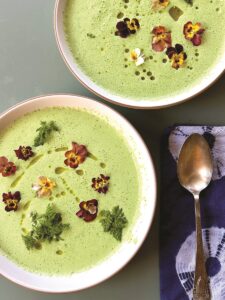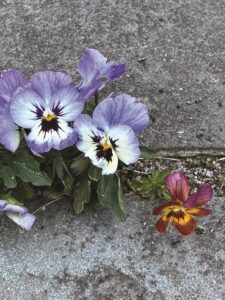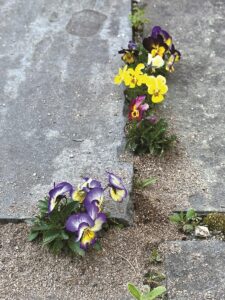I never used to pay much attention to pansies. When I first started gardening on the desolate expanse of a New York City tarpaper rooftop, I would plant only the small-flowered purple and yellow variety called johnny-jumps-up or heartsease. Plant snobs considered them somehow more tasteful than the flouncy big-faced pansies at the garden center and, full confession, I felt the same. But since I started gardening on the Cape a couple of years ago, I find myself falling hard for pansies — the bigger, the flouncier, the clashier the better.

Life can be difficult for plants in my new Truro garden, which is still in an experimental phase. I’m discovering what will grow where with my list of challenges. Much of my soil is sandy and unamended. We are well into our second year of drought. Bracing north winds sweep over from the back shore with great regularity. The only gardeners, my husband and me, can be away for stretches of time. All these factors demand species that are tough and independent.
Little did I know that one of my most stalwart successes would be a diminutive member of the pansy clan. After my first season of planting six-packs from the garden center, pansies now reseed everywhere: between paving stones, underneath hoses, in the lawn, smack in the middle of the gravel. Some even made it through our mild winter in sheltered spots, nodding off after the first frost and waking up again as temperatures climbed. I love how early they bloom, and during this time of year I grab a handful of them to decorate garden salads or cold soups.

Along with scented violets, pansies are in the genus Viola. It’s a large group of plants with deep historical associations. The heartsease or wild pansy (Viola tricolor) has been associated with thought and fondness for centuries. In the language of flowers, they say “think of me.” During the Tudor period, they were used in love potions and associated with the idea of missing, or longing for, a loved one. My research turned up an image of a purse that a young Elizabeth I embroidered with heartsease for her beloved stepmother Katherine Parr, the only wife to survive Henry VIII.
Why have violas, especially pansies, been linked with the idea of thought for so many years? The name pansy comes the French word for thinking, penser. My favorite etymological theory is that most pansies sport faces that look like they are scrunched up in deep thought — the kind of face you make when you are really trying to remember something.
That all-important face of the flower with its dark eye and nectar lines that direct the bees to their food is what gives the plant its personality. Pansies tend to aim their blooms in the same direction. I love seeing them arranged thickly in a pot, staring at me like a choir or a stadium of spectators.

The large-flowered hybrids don’t exist in nature; they are the outcome of intense plant breeding by competing aristocrats in early 19th-century England, reaching their height of popularity later in the century. It turns out that though they have a reputation for social conservatism, Victorians liked their pansies big, bright, and blowsy with as many blotches, cross-hatching, ruffles, picotees, and color combos as possible.
I wonder if this quality of defiant flamboyance might have contributed to the usage of pansy as an anti-gay slur. In the early to mid-20th century, several flower names were used as insults for gay or gender-nonconforming men, including buttercup (which had a resurgence recently as “suck it up, buttercup”), daffodil (popular in the 1930s), or lily (as in “lily-livered”), but the term pansy is the most famous and historically considered the most cutting. Is it because being thoughtful was considered an effeminate trait? Does it relate to the idea of a shrinking violet? Sidenote: violets have also historically been proud symbols of lesbian love. Pansy is, after all, not one of the worst epithets, and any member of the LGBTQ community, me included, can likely tell you exactly when and where we were when we’ve had harsher insults lobbed at us over the years.

But let’s not get weighed down by name-calling. What I like most about pansies is not just their patterning or their nearly full-spectrum color range. Growing them over the past several years has given me a new appreciation for how unstoppable they are when they find a place they like. They thrive in dry conditions, poking their way up through gravel and finding footing in the narrowest gap between pavers. They are weeds that you want, and I give them full rein.
Under all the flounces and the stylish colors (this year I’m really into the pinky-mauvy-browns and the ruffles of the Frizzle or Rococo series), what I admire most is their innate fierceness and their resolute but cheerful will to survive. Anybody who chooses to live on this windy, sandy, stormy spit of land jutting out into the Atlantic can probably identify. Let’s just say, it’s always unwise to underestimate a pansy.



